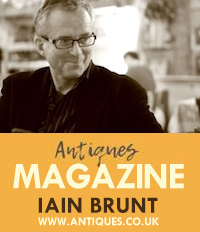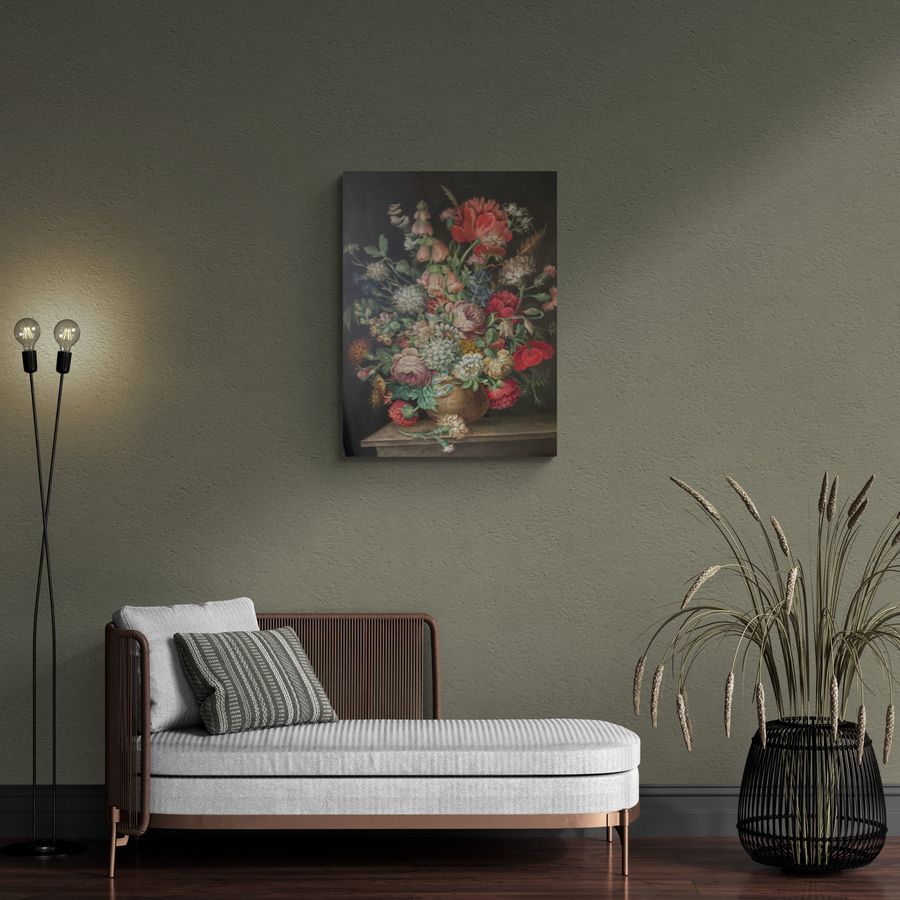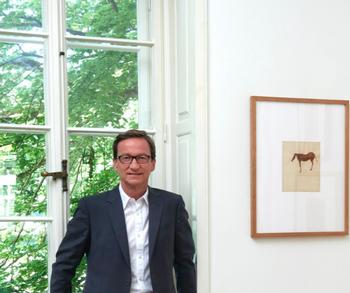Thaddaeus Ropac
Posted by Alain Elkann on 30/06/2020
BACK ON THE ROAD. Thaddaeus Ropac is an Austrian gallerist specializing in international contemporary art. He founded the Galerie Thaddaeus Ropac in 1981, and today represents more than 60 artists with his galleries in Salzburg, Paris Le Marais, Paris Pantin and London.
Thaddaeus Ropac, where are you?
I am in Salzburg because, when the Covid-lockdown happened in March this year, I was in Munich and I wanted to go to London but it was closed, and so I came to Salzburg, my city. I have been very conscious of the impact the pandemic has had, while I have been fortunate to be in splendid isolation, and living almost like a child. For the first time I felt how the trees bloom from their winter emptiness. As I said, I arrived in March. It was winter, and I saw every day how it exploded into green. In the last 30 years I never spent such a long time in one place. Now I am ready to move again and am already back on the road. Since mid-May / beginning of June we opened all the galleries in Salzburg, in Paris – the spaces in Pantin – and our office in Hong Kong. The London gallery was the last one, it opened last week.
How did you spend the last three months?
Most of the time was taken up with finding solutions to navigate through. We represent and support sixty artists, so I needed to speak to them, to be in contact with their studios, to make preparations, because almost every major show has been postponed. For instance, Alex Katz had to postpone a major exhibition in Sao Paulo in Brazil, an exhibition that we worked on together. Every day I was involved with changes. Georg Baselitz had a major exhibition at the Centre Pompidou in Paris but it was postponed for one year. We have to deal with new locations and secure them. In other words, “C’est la vie.”
“I felt how the trees bloom from their winter emptiness….and I saw every day how it exploded into green.”

The garden of gallerist Thaddaeus Ropac’s Villa Elmslieb, his private estate near Salzburg, Austria
Thaddaeus Ropac, did any of the artists that you represent fall ill?
No, fortunately, but we lost friends. The Italian critic and curator Germano Celant was a close friend. I saw him in February, and it was terrible to learn that he became a victim of Covid-19. In this extreme situation we were constantly in contact with the artists to be sure that they were okay.
Were they afraid?
Not so much. I did not feel that. Artists go on in solitude and create on their own.
What kind of work did the artists produce in the pandemia?
The artists used this period of isolation to do some of their best work. What will make this engine somehow get going again will be when people see the new work that will come out of the artists’ studios.
Why?
It has been a special time. In normal circumstances artists are constantly disturbed by visitors, galleries, museum directors and curators. During this period they were alone in their studios. I have seen photographs of what Anselm Kiefer did, and I went to Georg Baselitz’s studio here in Salzburg, and their work is breathtaking. I hope to go to Paris soon to see Kiefer’s work in person.
Are you doing a Kiefer exhibition in July in Salzburg?
Yes, and the exhibition will be about his work that was done before the coronavirus outbreak.
What is happening in the art market now?
For the first eight weeks, until the beginning of May, everything was closed. It was not the moment to sell art. Now, in the last two weeks, things have changed and became active. Collectors are eager to engage again. I don’t think people will travel much, but we opened a Daniel Richter show on June 6 and it went very well, and we also made sure to make the exhibition accessible with an online experience for those who couldn’t attend in person. Collectors can’t live for too long without looking at and buying art.
Are things going to change?
It will take some time to get back to anything close to normal, we might have to have more modestexpectations. This year will be difficult. Next year, when a vaccine has been found, people will return to what we are used to. I am optimistic.
“Nothing can compare to the atmosphere of a gallery, and they can be visited safely with social distancing.”
Thaddaeus Ropac, will prices go down?
I don’t think so. There will be a slower pace of selling. It’s true that some people try to make offers of lower prices, but we don’t cut our prices. There is no reason to do so. The pandemia has nothing to do with the value of an artwork, and we will defend our artists. At the beginning many sales were suspended. After Basel got cancelled we don’t even know if Frieze will take place. Realistically, I think that in one year people will go back to the pace of before. For the moment, our turnover will go down and we will sell much less. There will be no fairs in person, only online. But people will go back to art galleries. Our galleries have the best possible solution for artists to show their art work because of the space, the light. Nothing can compare to the atmosphere of a gallery, and they can be visited safely with social distancing.
What about auctions?
They will keep a very important role. Auctions will not have problems in the long run. This year of course it’s extremely challenging for them, like many other businesses, but auctions have such an important role in the art world and we know from experience how they recover. I am optimistic, and I think that in the foreseeable future we will go back to a sense of normality. We have all been changed to varying degrees by living through this experience, but the art world will recover.
Has it been hard for you?
Listen, we had both good and bad times in the past and we can manage some difficulty. I am more afraid for younger galleries who are just building up and represent young artists.
What can you do?
We have to think about how to help these young organisations survive. They are the future of our art world. For instance, with my team we have organised in my gallery in Pantin, in the outskirts of Paris where we have a very big space and have had great exhibitions, that in September we will invite sixty young artists represented by twenty or twenty-five galleries from Paris, Marseilles, Lyon and other places. Our gallery, across all of its infrastructure, will support young artists, collaborating with a non-profit organisation called Jeune Création that helps young artists. The Jeune Création team will make the selection of the artists and we will promote them, provide a platform, and the support of our team. We will try to help these new galleries and young artists as much as we can.
Have you felt that there has been some solidarity in the world of art?
Yes. Many big galleries are finding their own way of supporting, like Jeffrey Deitch in Los Angeles, Sadie Coles in London, Perrotin in Paris, and David Zwirner in New York, each one has tried in a different way, many on online platforms, to help young artists and galleries. This shows solidarity, and I think it helps.

Antony Gormley: IN HABIT.
Paris, Marais. Courtesy Galerie Thaddaeus Ropac. © Charles Duprat.

Georg Baselitz: Eisprinzessen, 2019
Oil on canvas. 250 x 200 cm. © Georg Baselitz. Photo Jochen Littkemann.

Jules de Balincourt: City People and Country Roads, 2020
Oil on panel. 203,2 x 177,8 cm. © Jules de Balincourt/ ADAGP, Paris 2020.

Daniel Richter: Oh, Flamingos, 2020
Oil on canvas. 244 x 186 cm. © Daniel Richter/VG Bildkunst, Bonn 2020. Photo Jochen Littkemann.

Daniel Richter: In Messern, 2020
Oil on canvas. 244 x 186 cm. © Daniel Richter/VG Bildkunst, Bonn 2020. Photo Jochen Littkemann.

Anselm Kiefer : Tandaradei – under der Linden an der Heide, dâ unser zweier bette was, dâ muget ir vinden schöne beide gebrochen bluomen unde gras, 2020.
Emulsion, oil paint, acrylic, shellac, chalk on canvas. 280 x 190 cm. © Anselm Kiefer. Photo Georges Poncet.
“I learnt that crises come and go, and, when you go through a crisis, in the long run it makes you stronger.”
Thaddaeus Ropac, what about the artists themselves?
In the beginning the pandemic and lockdown was a shock, but I felt that they used this period to create. My writer friends tell me that they did not write much. But for artists it was different, they could work.
How is the situation in Austria?
I have to say they manage well. In Salzburg there is not even one person left infected. Nothing went to the extreme because they seemed to be prepared. Every week they are easing the rules, and I feel that people are very responsible.
What about you?
I have had this incredible experience with nature. I am lucky and I have a garden, and I became more healthy. I lost weight and I did a lot of sports. I was working 10 hours a day on Zoom, but when I biked for one hour in the morning and one hour in the evening it was paradise. Before I was travelling constantly, every three days in a plane, and to stop it for two and a half months was a great experience. But I think I will soon be back to it. As a matter of fact, I cannot wait to go back to New York, Paris, London.
But what did you learn? How do you react to this time?
It’s been humbling to take a look at our lives and reassess, reprioritize and slow down and reflect. But I’m not frightened. I will be the first to be in a plane. We have to learn how to deal with it, how to be careful, how to protect ourselves but move on.
Do you think there will be a lot of poverty?
There’s no doubt that poverty is an impact of the pandemic. Those who are worst off have suffered more. I really hope that in a strong recovery this will be addressed, by governments and by us in society. I believe that we will be able to create new success, and I hope that most people will participate. I am an optimistic person. I went through the crisis of 1988 when my gallery was only five years old and slowly growing. There was a crash on the stock market and I wasn’t prepared and I had to work very hard. In 1991 there was another crisis, and then I was a bit more prepared. But then I learnt that crises come and go, and, when you go through a crisis, in the long run it makes you stronger.
ENJOY THIS INTERVIEW? SHARE IT WITH A FRIEND.






